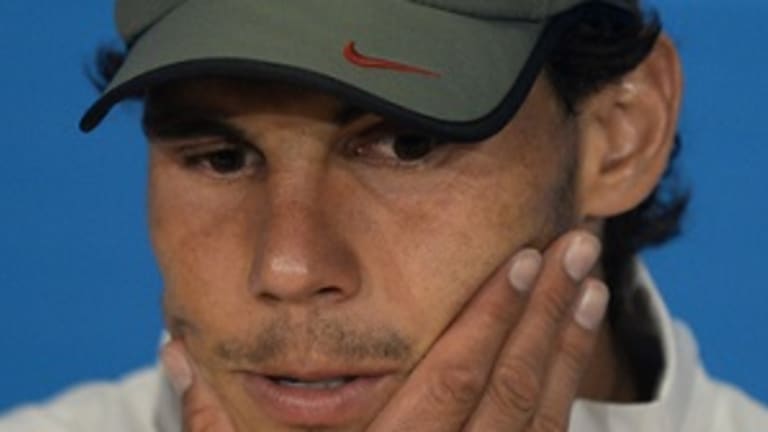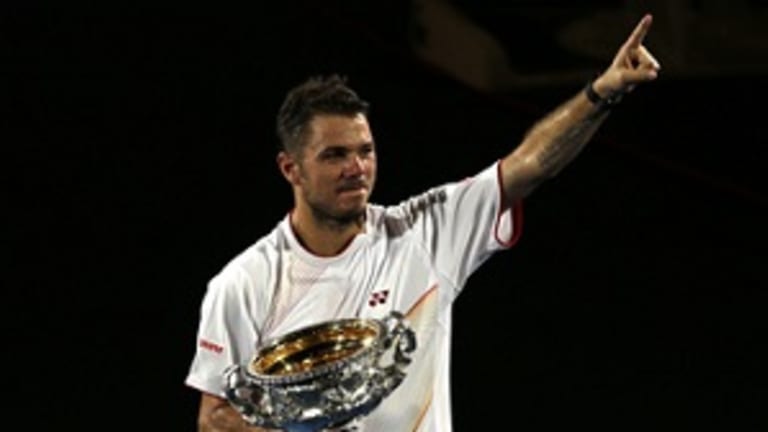MELBOURNE—“This wasn’t the way I wanted to win a tennis match,” Stan Wawrinka said a few minutes after winning the biggest tennis match of his life. “But it’s a Grand Slam, so you have to take it.”
“Take” is the operative word in that last sentence, because for an hour or so, Wawrinka didn’t look like he was ready to take what appeared to be the opportunity of his lifetime. Stan’s opponent, Rafael Nadal, had begun their Australian Open final as one of the heaviest favorites in the history of Grand Slam title matches. He and Wawrinka had played 12 times dating back to 2007, and Rafa hadn’t lost so much as a set. Nadal had won 13 Grand Slams; Wawrinka had never won a Masters title, let alone a major. In fact, since 2005 only one player outside the Big 4—Novak Djokovic, Roger Federer, Andy Murray, and Nadal—had won a major title. Yet all of those numbers, all of the history between these two players, all of the fabled air of the Big 4, had been rendered meaningless in the course of 80 minutes.
Wawrinka wasted no time ending his set-less streak to Nadal; guns blazing from the start, he had won the first set, 6-3. At the beginning of the second, Nadal had been laid low by a back injury that he had initially felt during the warm-up, and which had grown steadily worse. Now Rafa was arming his first serve over at 100 M.P.H. and hardly moving for balls hit anywhere but the center of the court. Down 1-5 in the second set, it looked for a second as if Nadal were heading to the net to shake hands, but on the way there he happened to knock off a forehand volley for a winner. After losing the second set a game later, though, he decided to keep going into a third.
That’s when Wawrinka, one set from his first Grand Slam title, an achievement he said he had “never even dreamed of before,” began to look this gift horse directly in the mouth. He couldn’t take the match. Pushing easy returns into the net and landing balloon-like ground strokes meters outside the lines, Stan gave the third set away to a slowly recovering Nadal.
"It wasn’t easy,” Wawrinka said. “He get injury. I saw that. He wasn’t serving at all. He wasn’t moving during one set. Then it was a completely different match. The problem is, I didn’t play well because I was waiting for him to miss. Because I was nervous, I was like, ‘OK, miss, miss, make a mistake, because I’m not going to win the match because I’m nervous.’”
Finally, Wawrinka stopped talking to Rafa in his head, and started to talking to himself.
“I had to focus on myself,” Wawrinka said, “to try to find the way just to win it.”
But even that wasn’t so easy. It seemed, with Nadal pushing his serve and not covering the sidelines, that all Wawrinka needed was to make a couple of service returns and the match would be over. And he did just that to break for 4-2, only to give that break back with two wild, skittish misses in the next game. Finally, Wawrinka took it for good with a forehand winner—his 53rd winner of the match—to break for 5-3. He celebrated by punching himself in the head three times.
“I don’t know if I’m dreaming,” Wawrinka said later, “we’ll see tomorrow morning.” Through his various post-match interviews, he seemed a little shell-shocked, a little too calm, as if it really hadn’t registered yet, and even when it did, he sill might not believe it.
He was asked, “What does winning a Grand Slam feel like?"
“To be honest," Stan answered in a slightly bewildered voice, "I don’t realize. Feels strange.”
It was strange, the whole match was strange, and in a way that was unfortunate for both players. You felt after the first set that Wawrinka had a good chance of winning even with Rafa at full strength. The new Swiss No. 1 was flowing easily around the court, getting every shot he wanted, and hitting a large share of them for winners. When he did tighten up while serving at 5-3, Nadal tightened up right back and squandered three break points with return errors on easy second serves.
“I was a little bit surprised at how well I was playing at the beginning,” Wawrinka said with a smile. “But I came on court believing in myself.” Stan credited his five-set win over Djokovic in the quarterfinals as the source of his belief tonight.

